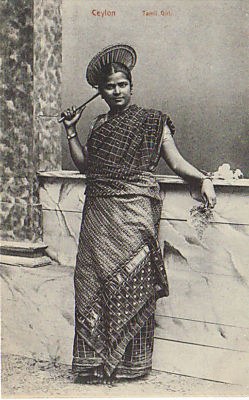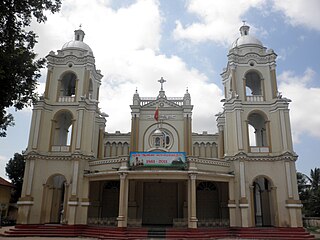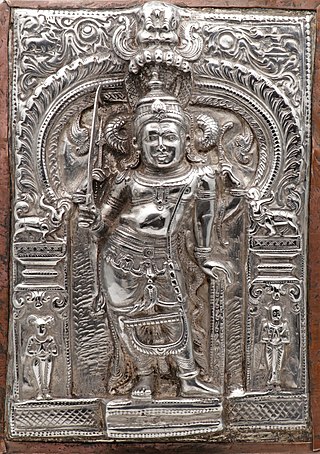Related Research Articles
The caste systems in Sri Lanka are social stratification systems found among the ethnic groups of the island since ancient times. The models are similar to those found in Continental India, but are less extensive and important for various reasons, although the caste systems still play an important and at least symbolic role in religion and politics. Sri Lanka is often considered to be a casteless or caste-blind society by Indians.

Sri Lankan Tamils, also known as Ceylon Tamils or Eelam Tamils, are Tamils native to the South Asian island state of Sri Lanka. Today, they constitute a majority in the Northern Province, form the plurality in the Eastern Province and are in the minority throughout the rest of the country. 70% of Sri Lankan Tamils in Sri Lanka live in the Northern and Eastern provinces.
Sri Lankan Mukkuvar is a Tamil speaking ethnic group found in the Western and Eastern coastal regions of Sri Lanka. They are primarily concentrated in the districts of Batticaloa, Ampara and Puttalam. They are also related to "Sri Lankan Moors". Sri Lankan Mukkuvars along with Eastern tamils of Sri Lankan claim their origin from Kerala and matrilineal in practice. Recent studies show their habits and clan structure, as well as dialects, show affinity towards the Northern Kerala regions.
Nalavar is a Tamil caste found in Sri Lanka. They were traditionally occupied in palm tree climbing and toddy tapping.
Koviyar is a Tamil caste found in Sri Lanka. They are traditional agriculturalists and temple workers but also included merchants, landowners and temple patrons. Kattavarayan as caste deity is observed by the Koviar. They are reputed as a ritually dominant caste and the "cousin" caste of the more numerical dominant caste, Sri Lankan Vellalar.
Karaiyar is a Sri Lankan Tamil caste found mainly on the northern and eastern coastal areas of Sri Lanka, and globally among the Tamil diaspora.
Village deities are a common feature of the Hindu pantheon of deities. They are known as Gramadevatas. Each Hindu region and caste of India and South Asia has its share of village deities. Sri Lankan Tamils venerate their own group of village deities throughout Sri Lanka, specifically in the Tamil-dominated north and east of the island nation.

Sri Lankan place name etymology is characterized by the linguistic and ethnic diversity of the island of Sri Lanka through the ages and the position of the country in the centre of ancient and medieval sea trade routes. While typical Sri Lankan placenames of Sinhalese origin vastly dominate, toponyms which stem from Tamil, Dutch, English, Portuguese and Arabic also exist. In the past, the many composite or hybrid place names and the juxtaposition of Sinhala and Tamil placenames reflected the coexistence of people of both language groups. Today, however, toponyms and their etymologies are a source of heated political debate in the country as part of the political struggles between the majority Sinhalese and minority Sri Lankan Tamils.
Sri Lankan Vellalar is a caste in Sri Lanka, predominantly found in the Jaffna peninsula and adjacent Vanni region, who comprise about half of the Sri Lankan Tamil population. They were traditionally involved in agriculture, but also included merchants, landowners and temple patrons. They also form part of the Sri Lankan Tamil diaspora.
Vanniar or Vanniyar was a title borne by chiefs in medieval Sri Lanka who ruled in the Chiefdom of Vavuni regions as tribute payers to the Jaffna vassal state. There are a number of origin theories for the feudal chiefs, coming from an indigenous formation. The most famous of the Vavni chieftains was Pandara Vannian, known for his resistance against the British colonial power.

The Vanni chieftaincies or Vanni principalities was a region between Anuradhapura and Jaffna, but also extending to along the eastern coast to Panama and Yala, during the Transitional and Kandyan periods of Sri Lanka. The heavily forested land was a collection of chieftaincies of principalities that were a collective buffer zone between the Jaffna Kingdom, in the north of Sri Lanka, and the Sinhalese kingdoms in the south. Traditionally the forest regions were ruled by Vedda rulers. Later on, the emergence of these chieftaincies was a direct result of the breakdown of central authority and the collapse of the Kingdom of Polonnaruwa in the 13th century, as well as the establishment of the Jaffna Kingdom in the Jaffna Peninsula. Control of this area was taken over by dispossessed Sinhalese nobles and chiefs of the South Indian military of Māgha of Kalinga (1215–1236), whose 1215 invasion of Polonnaruwa led to the kingdom's downfall. Sinhalese chieftaincies would lay on the northern border of the Sinhalese kingdom while the Tamil chieftaincies would border the Jaffna Kingdom and the remoter areas of the eastern coast, north western coast outside of the control of either kingdom.
Kandarodai is a small hamlet and archaeological site of Chunnakam town, a suburb in Jaffna District, Sri Lanka.
Social class in Sri Lanka is often described as casteless, though caste is still found on the island in both a symbolic and a practical sense. Caste is also used in an analogous sense to refer to the new social class divisions that have appeared in recent decades. The combination of ethnic nationalist movements that saw caste as an island-wide dividing tool, strong emphasis on providing access to education and healthcare regardless of background, and historic lack of discrimination among the colonial civil service played a factor in eradicating the caste system in most sectors of the island's society. Although the Buddhist culture actively fought against all forms of class discrimination, many Buddhist organizations used caste as a method to extract surplus from temple property.

Gurunagar is a coastal village in Jaffna city in northern Sri Lanka. Gurunagar is also known as Karaiyur.

Vannar is a Tamil caste found primarily in the Indian state of Tamil Nadu and northeastern parts of Sri Lanka. The community has traditionally been involved in laundry. also agricultural workers They are in Tamil Nadu classified as Most Backward Class.
Thimilar is a Sri Lankan Tamil caste found in the northern and eastern coastal areas of Sri Lanka, and globally among the Tamil diaspora. They are traditional artisanal fishers primarily engaged in shallow-water fishing. In Eastern Sri Lanka are they also involved in cattle cultivation.
Madapalli is a caste found mainly in the northern part of Sri Lanka. Found today as a subcaste of the Sri Lankan Vellalar, the Madapallis were considered an independent caste until recently.
Cantar is a Tamil caste found in Sri Lanka. They are traditionally occupied in Oil-pressing and cultivation.
Sri Lankan Paraiyar is a Tamil caste found in northern and eastern Sri Lanka. They are traditional parai-drummers who were also involved in weaving and scavenging.
Sri Lankan Pallar is a Tamil caste found in northern and eastern Sri Lanka. They are traditionally involved in agriculture and were also involved in toddy tapping and artisanal fishing.
References
- 1 2 McGilvray, Dennis B. (2008-05-07). Crucible of Conflict: Tamil and Muslim Society on the East Coast of Sri Lanka. Duke University Press. p. 236. ISBN 978-0-8223-8918-7.
- ↑ "Thurumbar, the Dalits of the Dalits". SHAPE. 2020-05-29. Retrieved 2021-01-17.
- 1 2 3 4 Leach, E. R. (1960). Aspects of Caste in South India, Ceylon and North-West Pakistan. CUP Archive. pp. 64, 65–66. ISBN 978-0-521-09664-5.
- ↑ Perinbanayagam, R. S. (1982). The Karmic Theater: Self, Society, and Astrology in Jaffna. University of Massachusetts Press. p. 31. ISBN 978-0-87023-374-6.
- ↑ Parkin, Robert (2020-05-19). South Asia in Transition: An Introduction to the Social Anthropology of a Subcontinent. Rowman & Littlefield. p. 261. ISBN 978-1-7936-1179-6.
- ↑ Kanakasabhapathipillay, Kolappapillay (1963). South India and Ceylon. University of Madras. p. 167.
- ↑ Holmes, Walter Robert (1980). Jaffna, Sri Lanka 1980. Christian Institute for the Study of Religion and Society of Jaffna College. p. 232.
- ↑ Ragupathy, Ponnampalam (1987). Early Settlements in Jaffna: An Archaeological Survey. University of Jaffna. p. 210.